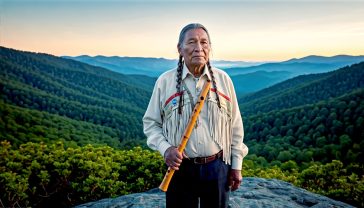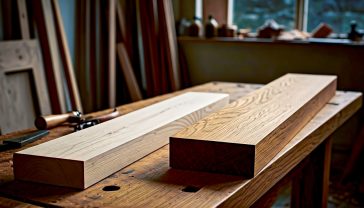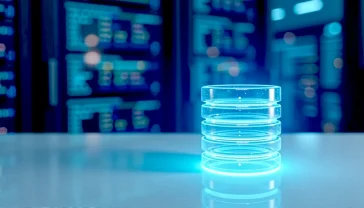The Animation Guide: How to Breathe Life into Your Drawings
Ever wondered how cartoons are made? Our definitive guide explains everything, from classic British animation like Wallace & Gromit to the future of CG.
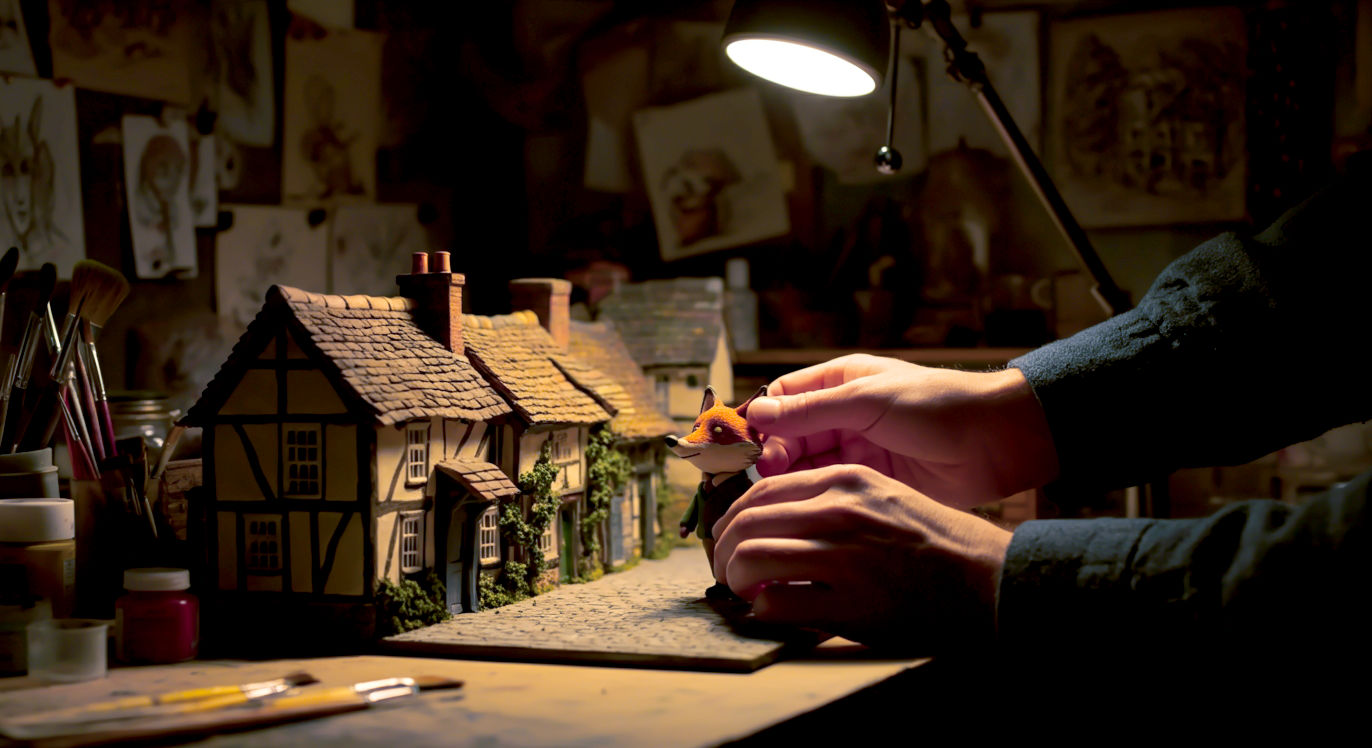
This post may contain affiliate links. If you make a purchase through these links, we may earn a commission at no additional cost to you.
Have you ever watched a cartoon and wondered, “How on earth did they do that?” One moment there’s a still drawing, and the next, it’s a character running, jumping, and pulling funny faces. It feels like magic, doesn’t it? But it’s not magic, it’s animation, the incredible art of making things move.
For decades, Britain has been a quiet powerhouse in the world of animation. From the charming farmyard antics of Shaun the Sheep to the epic rabbit adventure in Watership Down, our animators have told stories that stick with us forever. Animation isn’t just for kids’ cartoons on a Saturday morning; it’s in blockbuster films, mind-bending video games, and even the adverts you see on telly.
This guide is your key to unlocking that world. We’ll start with the absolute basics, explore the amazing history of animation (with a few British legends thrown in), and break down the different ways artists bring their creations to life. Whether you’re a budding artist doodling in a notepad or just curious about how your favourite animated films are made, you’ve come to the right place. Let’s dive in and discover how to make the inanimate, animate.
What Exactly Is Animation? The Core Idea Explained
At its heart, animation is a clever trick played on our eyes and brain. It’s the process of showing a series of still images one after another, very quickly. Each image is slightly different from the one before it. When you flick through them fast enough, your brain blurs the images together and creates the illusion of movement.
Think of a flicker book. You draw a simple stick figure on the corner of a notepad. On the next page, you draw the same figure but move its arm a tiny bit. You repeat this over dozens of pages. When you flick the pages with your thumb, the stick figure appears to wave at you. That’s animation in its purest form!
This illusion has a fancy name: persistence of vision. It’s the idea that our eyes hold onto an image for a split second after it has disappeared. When the next image appears in that split second, our brain connects the two, creating a smooth sense of motion where there is none.
Filmmakers and animators figured out that to make this movement look believable, they needed to show about 24 images, or “frames,” every second. This is known as the frame rate. Some animations use fewer frames (like 12 per second) for a jerkier, more stylised look, while modern video games can use 60 frames per second or more for ultra-smooth gameplay. But the basic principle is always the same: a sequence of still pictures shown quickly to create the illusion of life.
The 12 Principles of Animation: The Animator’s Bible
In the 1930s, a group of pioneering animators at Walt Disney Studios in America came up with a set of rules to make their animations look more realistic and full of character. These became known as the 12 Principles of Animation. They are the fundamental building blocks that animators all over the world, including here in Britain, still use today. Understanding them is like learning the grammar of animation.
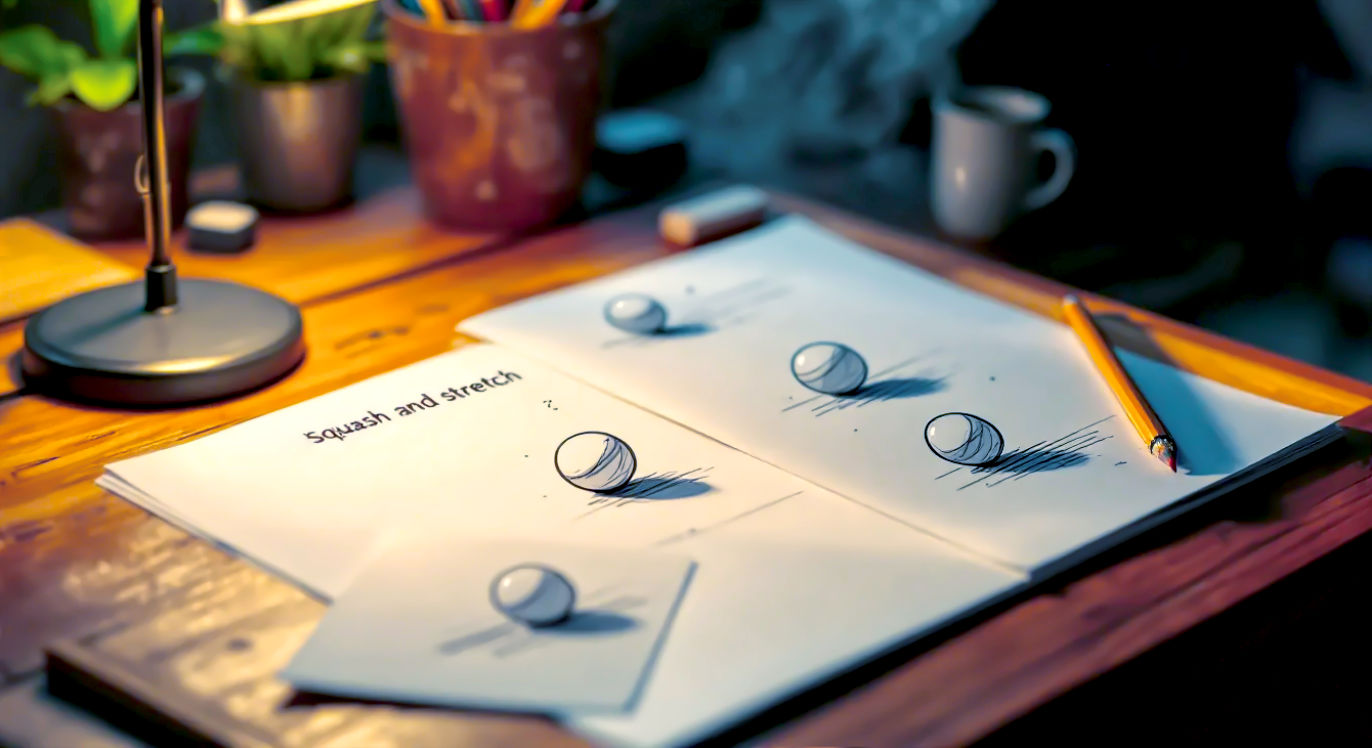
1. Squash and Stretch
This is the big one. It gives your characters and objects a sense of weight, flexibility, and mass. Imagine a bouncing rubber ball. As it hits the ground, it squashes flat. As it flies back up, it stretches out. Applying this to a character’s face can show emotion—squashed for anger, stretched for surprise. The key is to keep the object’s volume the same. If it gets wider (squashes), it must also get shorter.
2. Anticipation
This is the setup for an action. Before a character jumps, they bend their knees. Before they throw a punch, they swing their arm back. Anticipation prepares the audience for what’s about to happen and makes the final action more powerful and believable.
3. Staging
This is about presenting an idea so that it is unmistakably clear. It’s like being a director on a film set. You need to make sure the audience is looking at the right thing at the right time. This could mean placing the character in the frame correctly, using lighting to draw attention, or choosing the perfect camera angle.
4. Straight Ahead Action and Pose to Pose
These are two different ways to draw an animation.
- Straight Ahead Action is where you draw frame by frame from start to finish. It’s great for unpredictable action, like a fire or an explosion, as it feels spontaneous and fresh.
- Pose to Pose is where you draw the key poses first—the beginning, middle, and end of an action. Then you go back and draw the frames in between. This gives you more control and is better for character-driven scenes where emotion and timing are critical.
5. Follow Through and Overlapping Action
In the real world, things don’t just stop dead. When a character with a long coat stops running, the coat will continue to swing forward for a moment. That’s Follow Through. Overlapping Action is the idea that different parts of the body move at different rates. For example, a character’s arms might move at a different speed to their head. These principles make movement feel more natural and fluid.
6. Slow In and Slow Out
Objects and characters need time to accelerate and decelerate. A car doesn’t instantly go from 0 to 60 mph. It starts slowly, speeds up, and then slows down before stopping. In animation, this is achieved by adding more drawings at the beginning and end of an action and fewer in the middle. This creates a smoother, more realistic motion.
7. Arcs
Almost all living things move in arcs or slightly circular paths. A character’s arm, a thrown ball, or even a head turn will follow a gentle arc. Sticking to this principle prevents the animation from looking stiff and robotic.
8. Secondary Action
This is a smaller action that supports the main action. Imagine a character whistling while walking down the street. The walking is the main action; the whistling is the secondary action. It adds another layer to the character, making them feel more alive and real without distracting from the main point of the scene.
9. Timing
This refers to the number of frames used for an action. More frames make the action slower and smoother, which can convey sadness or exhaustion. Fewer frames make it faster and sharper, which is great for excitement or panic. Getting the timing right is crucial for communicating a character’s mood and personality.
10. Exaggeration
Animation is not about perfectly copying reality. It’s about presenting reality in a more convincing and entertaining way. Exaggeration helps to push movements and expressions further to make them more dynamic. A surprised character’s jaw might literally drop to the floor. It’s not realistic, but it gets the feeling across perfectly.
11. Solid Drawing
This principle is all about making sure your characters look like they are in a three-dimensional space, with volume, weight, and balance. You need to think about form, anatomy, and perspective to avoid your characters looking flat and lifeless.
12. Appeal
This is the quality that makes a character charismatic and interesting to watch. It doesn’t mean they have to be cute and cuddly—villains can have appeal too! It’s about creating a design that is compelling and has a unique personality that audiences can connect with.
A Whirlwind Tour of Animation History
The desire to bring images to life is as old as humanity itself. Cave paintings from thousands of years ago show animals with extra legs to suggest movement. But modern animation truly began in the 19th century with a series of strange and wonderful inventions.
The Victorian Pioneers
Before cinema was even invented, Victorians were fascinated with moving images. They created gadgets with brilliant names like the Phenakistoscope and the Zoetrope. These were spinning discs or drums with slits in them. When you looked through the slits at a series of drawings inside, they appeared to move. It was the flicker book on a grander scale and the talk of parlours across Britain.
The Birth of Animated Film
At the dawn of the 20th century, filmmakers started experimenting with animation. One of the first true animated stars was Gertie the Dinosaur (1914), created by the American Winsor McCay. Audiences were stunned as McCay interacted with his cartoon creation on screen.
But it was Walt Disney who turned animation into an art form. Steamboat Willie (1928), starring a certain mouse, was a sensation because it synchronised sound with the animation. A few years later, Snow White and the Seven Dwarfs (1937) proved that an animated film could be just as powerful and emotional as a live-action one.
The British Animation Story
While America had Disney, Britain was developing its own unique animation voice. In the 1950s, Halas and Batchelor, a studio run by husband-and-wife team John Halas and Joy Batchelor, created Britain’s first feature-length animated film, Animal Farm (1954). Based on George Orwell’s dark political novel, it was a world away from Disney’s fairy tales and showed that animation could tackle serious, adult themes.
The 1970s and 80s were a golden age for British animation. TV shows like The Wombles and Paddington Bear used a technique called stop-motion, where physical puppets are moved tiny amounts between frames. This gave them a charming, handmade feel. At the same time, films like Watership Down (1978) and The Snowman (1982) captivated audiences with their beautiful, hand-drawn artistry and emotional storytelling. These weren’t just cartoons; they were powerful pieces of cinema.
Then came Aardman Animations. Based in Bristol, this studio became world-famous for its incredible stop-motion creations, particularly Wallace and his long-suffering dog, Gromit. Films like The Wrong Trousers (1993) and A Close Shave (1995) won Oscars and cemented Britain’s reputation for quirky, characterful, and brilliantly clever animation.
Types of Animation: The Animator’s Toolkit
There isn’t just one way to make an animation. Artists have a whole box of tools and techniques to choose from, each with its own look and feel.
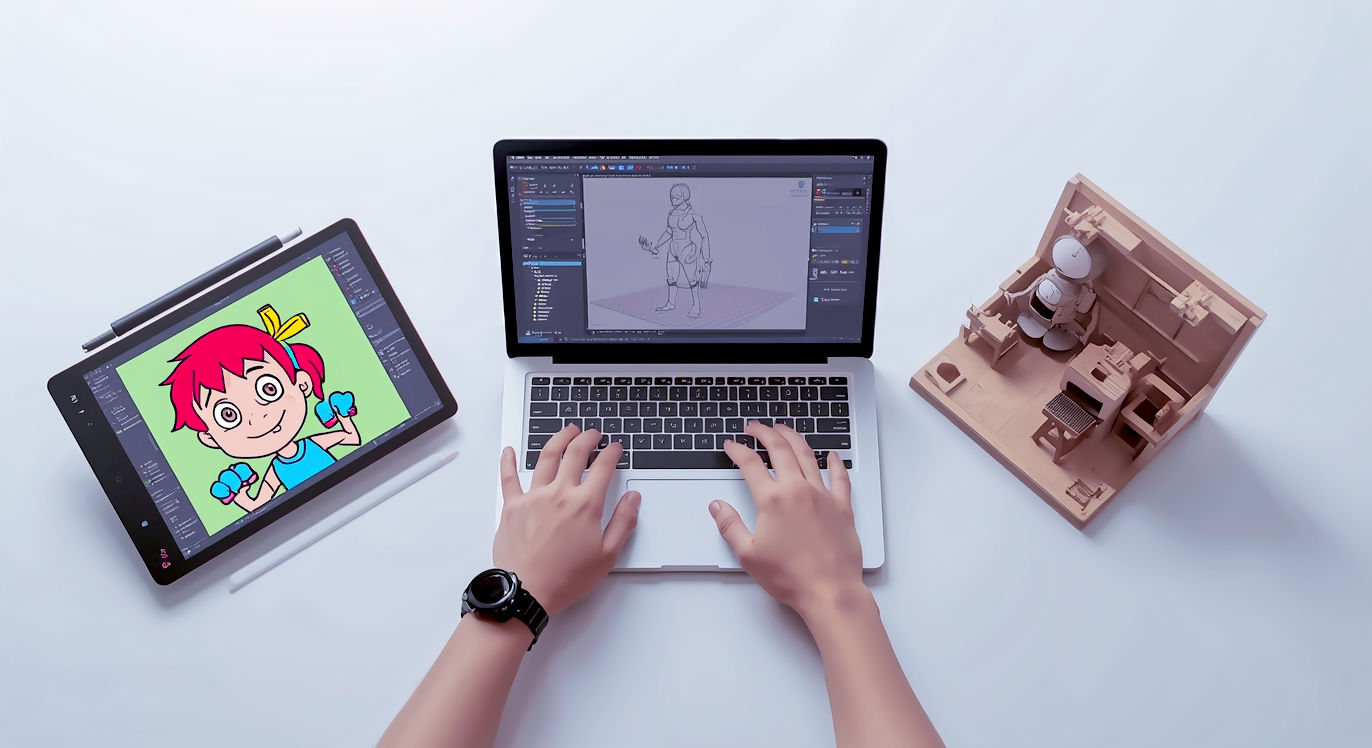
1. Traditional Animation (2D or Cel Animation)
This is the classic method used for films like The Lion King and The Little Mermaid. Each frame is drawn by hand on a transparent sheet called a “cel.” The cels are then placed over a painted background and photographed one by one.
- How it feels: It has a beautiful, organic, and often nostalgic quality. The artist’s hand is visible in every line.
- Modern twist: Today, most 2D animation is done digitally using drawing tablets and software like Toon Boom Harmony or TVPaint. This saves a huge amount of time and paper, but the core principle of drawing frame by frame remains the same. The popular BBC children’s show Hey Duggee is a great example of modern 2D digital animation.
2. Stop-Motion Animation
This is the technique of bringing physical objects to life. Animators build puppets or models and move them fractionally between each photograph. When the photos are played back, the objects appear to move on their own.
- Claymation: A famous type of stop-motion where characters are made from plasticine or clay. Aardman’s Shaun the Sheep is the perfect example. The clay gives the characters a wonderful tactile quality.
- Puppet Animation: This uses more structured puppets with internal armatures (skeletons). The film Fantastic Mr. Fox (2009) is a masterpiece of puppet animation.
- Cut-out Animation: This uses characters made from flat pieces of paper or card. The classic children’s series Ivor the Engine used this simple but effective style.
- How it feels: Stop-motion has a unique, tangible charm. You can feel the real-world texture of the materials, which makes the characters feel wonderfully present.
3. Computer-Generated (CG) Animation
This is what most people think of when they hear the word “animation” today. It covers a vast range of styles, from the hyper-realism of Hollywood blockbusters to stylised video games.
- 3D Animation: This is the style popularised by studios like Pixar (Toy Story, Finding Nemo). Artists build characters and environments as digital 3D models inside a computer. They then create a digital skeleton (a “rig”) for the character and move it frame by frame, just like a digital puppet. The computer then calculates the lighting, textures, and camera angles to create the final image, a process called “rendering.”
- 2D CG Animation: This uses computers to create a 2D look, often mimicking traditional animation. It’s faster and more flexible than hand-drawn animation. Many modern TV shows use this method.
- How it feels: CG animation can look incredibly realistic and polished. It allows for complex camera movements and detailed worlds that would be impossible to create by hand.
4. Motion Graphics
This is a type of animation that you see every day, often without realising it. It’s the art of making text, logos, and other graphic elements move. Think of the animated opening titles of a TV show, an explainer video on a website, or the weather forecast graphics on the news. It’s less about telling a story with characters and more about communicating information in a clear and visually interesting way. Software like Adobe After Effects is the industry standard for this.
How Is an Animation Actually Made? From Idea to Screen
Creating an animation, whether it’s a 30-second advert or a 90-minute film, is a huge team effort that follows a clear process. This process is often broken down into three main stages:
Stage 1: Pre-Production (The Planning)
This is where all the thinking and planning happens before a single frame is animated. It’s the most important stage because a good plan saves a lot of time and money later on.
- The Idea and Script: It all starts with a story. What happens? Who are the characters? What do they want? This is all written down in a script.
- Concept Art: Artists draw and paint images to figure out the look and feel of the film. What do the characters look like? What kind of world do they live in? This helps everyone on the team get on the same page.
- Character Design: This is where the stars of the show are created. Artists will do hundreds of sketches to find the perfect design for each character, thinking about their personality, shape, and how they will move.
- Storyboarding: The entire script is drawn out as a series of comic-book-like panels. The storyboard shows what happens in each shot, what the characters are doing, and what the camera sees. It’s like a visual blueprint for the whole animation.
- Animatic: The storyboard panels are put into a video timeline and timed out with dialogue and temporary music. This gives the team their first real sense of how the film will flow and if the jokes or emotional moments are working.
Stage 2: Production (The Making)
This is where the animation is actually created. It’s the longest and most labour-intensive part of the process. What happens here depends on the type of animation being made.
- For 2D Animation: This involves layout (planning the backgrounds), background painting, character animation (drawing the frames), and clean-up (making sure all the lines are neat and consistent).
- For Stop-Motion: This involves building the sets and puppets, and then the slow, painstaking process of animating them frame by frame on set. Animators will often only complete a few seconds of footage per day.
- For 3D CG Animation: This involves modelling (building the 3D assets), texturing (painting the surfaces of the models), rigging (creating the digital skeletons), and finally, animation (posing the digital puppets frame by frame).
This stage also includes voice acting. Professional actors record all the dialogue before the animation begins, as the animators need to match the character’s mouth movements to the sound. This is called lip-syncing.
Stage 3: Post-Production (The Polishing)
Once all the animation is done, it’s time to put it all together and make it shine.
- Compositing and Visual Effects (VFX): All the different layers of the animation (characters, backgrounds, special effects like smoke or rain) are combined into the final shot.
- Sound Design and Music: Sound effects are added to make the world feel real—footsteps, doors closing, birds singing. A composer writes a musical score to enhance the emotion of the story.
- Editing: The final shots are assembled in the correct order, and the pacing is fine-tuned to make sure the story flows perfectly.
- Colour Grading: The colours of the final film are adjusted to create a consistent mood and look.
Getting Started in Animation: Your First Steps
Feeling inspired? The good news is that you don’t need a fancy studio to start animating. With today’s technology, anyone with a bit of patience and creativity can learn the basics.
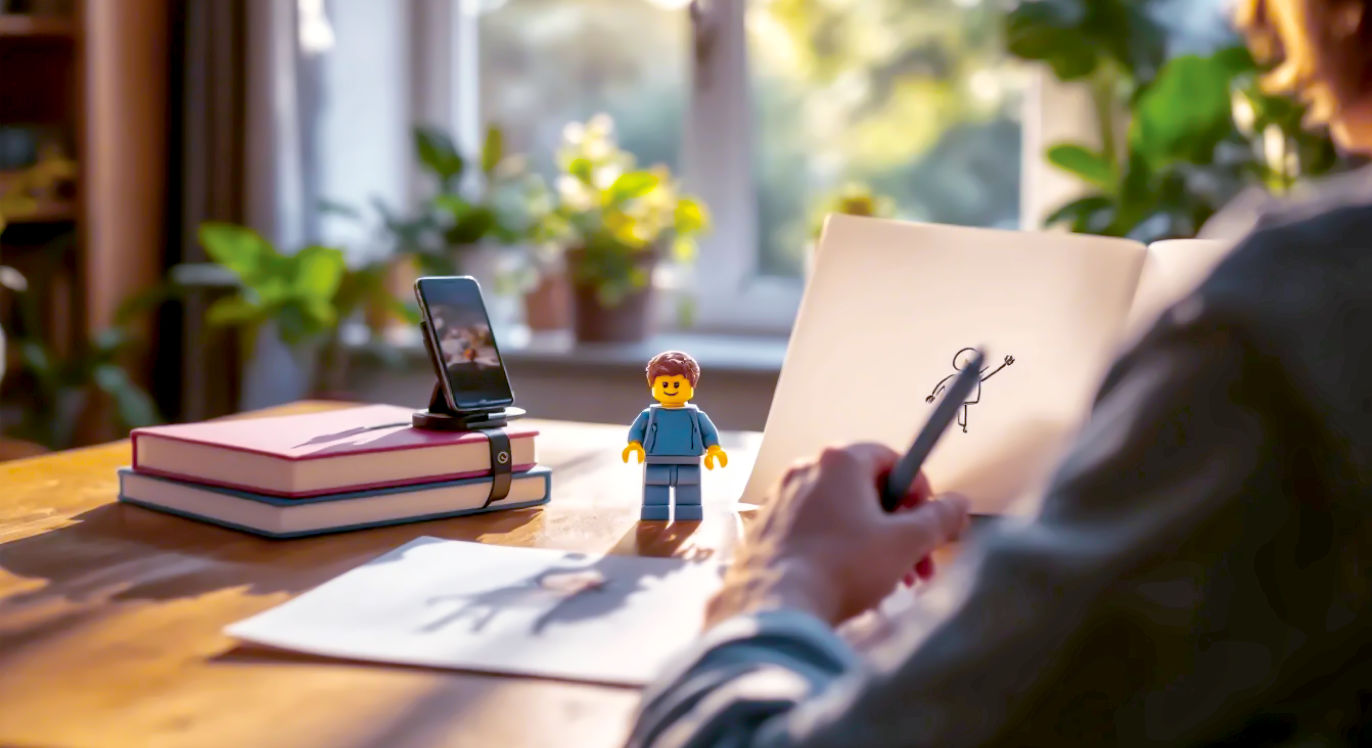
Simple Tools to Begin With
- A Pen and Paper: The humble flicker book is the best place to start. All you need is a notepad and a pen. It’s a fun and easy way to get a feel for the principles of timing and spacing.
- Your Smartphone or Tablet: There are dozens of brilliant, easy-to-use animation apps available. Apps like Stop Motion Studio are great for beginners wanting to try stop-motion with LEGO figures or clay models. For 2D animation, apps like FlipaClip let you draw frame by frame right on your screen.
- Free Software for Your Computer: If you want to take things a step further, there is some amazing free software out there. Blender is an incredibly powerful, professional-grade 3D animation program that is completely free. It can be a bit daunting at first, but there are thousands of free tutorials on YouTube to help you learn. For 2D animation, Krita is a fantastic free drawing program that also has animation tools.
What to Learn First
Don’t try to animate a complex character walking and talking on your first day. Start simple.
- The Bouncing Ball: This is the classic first exercise for any animator. It teaches you about timing, spacing, squash and stretch, and arcs. Try to make the ball feel heavy, then light, then sticky.
- Focus on the Principles: Once you’re comfortable with the bouncing ball, try applying the other principles of animation. Animate a pendulum swinging to learn about slow in and slow out. Animate a brick falling to understand weight.
- Observe the World: The best animators are people-watchers. Go to a park or a café and just watch how people move. How do they walk when they’re happy versus when they’re sad? How does a dog wag its tail? Keep a sketchbook and draw what you see. Animation is all about observing life and bringing that observation into your work.
The Future of Animation: What’s Next?
Animation is always changing. New technology is constantly opening up new creative possibilities. So what does the future hold?
- Real-Time Animation: Traditionally, rendering a 3D animation takes a huge amount of computer power and time. But modern video game engines, like the Unreal Engine, can now render incredibly realistic images in real-time. This is changing how animations are made, allowing directors to see the final shot instantly instead of waiting hours or days.
- Virtual Reality (VR) and Augmented Reality (AR): These new technologies are creating completely new ways to tell stories. Instead of just watching a film on a screen, audiences can step inside the animated world and interact with it. British studios are already experimenting with creating immersive animated experiences for VR headsets.
- Artificial Intelligence (AI): AI tools are being developed that could help to automate some of the more repetitive parts of the animation process, like drawing the in-between frames or adding colour. This could free up artists to focus more on the creative side of things.
But no matter how advanced the technology gets, the one thing that will never change is the importance of a good story and appealing characters. The tools will evolve, but the art of bringing figures to life will always be about creativity, observation, and a touch of that old-fashioned magic.
Further Reading
To continue your journey into the world of animation, here are some highly respected resources:
- Skwigly Animation Magazine: A fantastic online magazine dedicated to the animation industry, with a strong focus on British and independent animation.
- Aardman Animations – The Studio’s Official Website: Explore the world of Wallace & Gromit, Shaun the Sheep, and discover behind-the-scenes insights from the Bristol-based masters of stop-motion.
- The Animator’s Survival Kit by Richard Williams: Widely considered the bible of animation. Written by the legendary animator of Who Framed Roger Rabbit, this book is an essential resource for anyone serious about learning the craft.
- Blender – Official Website: Download the incredible free 3D animation software and access a huge community and library of tutorials to get you started.




